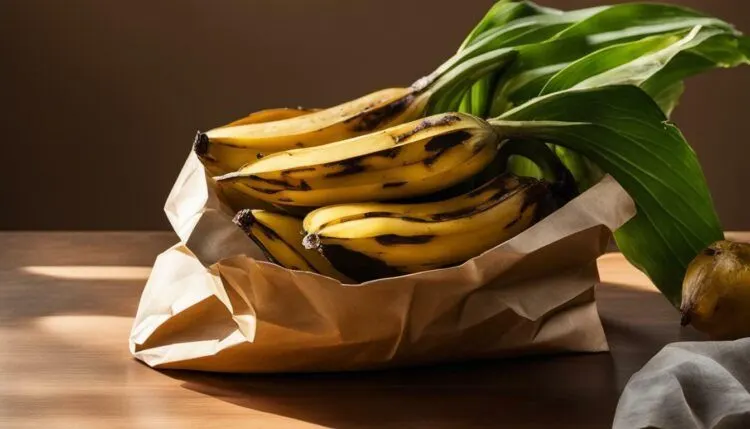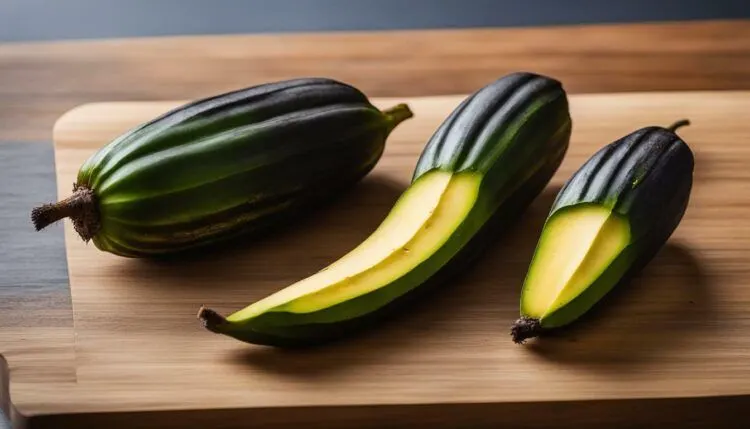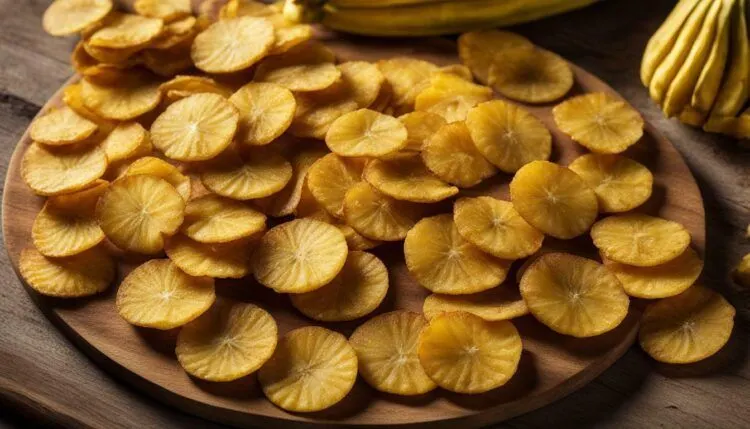Plantains are a staple in many dishes, but unripe plantains can be hard to work with and lack the sweetness of ripe ones. Luckily, there are easy and fast methods to ripen plantains at home. Read on if you want to know how to ripen plantains.
There are several methods you can try to ripen plantains quickly and easily at home. You can use a ripe banana, brown paper bag, and olive oil in some of these methods. Another well-known technique to ripen plantains quickly at home is to influence room temperature and have them in a warm environment.
Key Takeaways:
- Unripe plantains can be hard and lacking in sweetness, making them difficult to use in dishes.
- There are easy and fast methods to ripen plantains at home.
- Using a brown paper bag and room temperature is an effective method.
- Ripe bananas can be used to help ripen plantains quickly.
- Understanding the ripening process is essential to know when plantains are ready to be consumed.
The Ripening Process of Plantains
Plantains, like other fruits, go through a ripening process that changes their color and texture. The ripening process of plantains can take anywhere from a few days to a week or more, depending on the stage of ripeness and the method used to ripen them.
Unripe plantains are green and firm to the touch with no black spots or brown spots. As they ripen, they start to turn yellow with brown spots, and the fruit becomes softer. At the green stage, plantains are starchy and have a very mild flavor. As they ripen and the color changes to yellow, the natural sugars in the fruit increase, resulting in a sweeter taste.
When checking for ripeness, it’s important to look for the right color and texture. Ripe plantains will have a yellow color with black spots or brown spots, indicating that they are soft and sweet. The interior of the fruit should also be yellow and not white or green, indicating that it has reached peak ripeness.
Overall, understanding the different stages of ripeness and what to look for in terms of color and texture is essential to know when plantains are ready to be consumed.

If you’re looking for a simple and effective way to speed up the ripening process of your plantains at home, try using a brown paper bag and room temperature. This technique is a natural way to ripen your fruit without any chemical additives.
Simply place your unripe plantains in a brown paper bag and keep them at room temperature. Make sure to fold the top of the bag to keep the ethylene gas that the plantains produce inside, which will speed up the ripening process.
Why does this method work? It mimics the natural ripening process of tropical fruits, which are often sold unripe in grocery stores. The fruits are then placed in a warm and humid environment, where they naturally ripen over time. By using a brown paper bag and room temperature, you create a similar environment in your own home.
If you want to speed up the process even more, add a ripe banana to the bag. As we mentioned earlier, ripe bananas produce ethylene gas, which helps speed up the ripening process of other fruits, including plantains.
This method works particularly well with green plantains, which are often sold unripe and need to be ripened before they can be used in recipes. By using a brown paper bag and room temperature, you can ripen your green plantains in just a few days.
If you don’t have a brown paper bag, you can also use a cardboard box or a paper towel to wrap your plantains. Just make sure to keep them at room temperature in a warm and dry place to speed up the ripening process.

The Ripe Banana Method
If you want to ripen plantains quickly, try using ripe bananas. Bananas naturally produce ethylene gas, which speeds up the ripening process. By placing a ripe banana alongside unripe plantains, you can take advantage of this natural process.
The natural sugars in ripe bananas can also help sweeten your plantains as they ripen. This is especially useful if you prefer sweet plantains, which are yellow with black spots. If you prefer yellow plantains with no black spots, simply remove the ripe banana once the desired level of ripeness is achieved.
You can easily find ripe bananas in your local grocery store. Look for bananas with a yellow skin and some brown spots. These bananas are usually past their prime for eating but perfect for ripening plantains.

This method is effective and straightforward. Simply place a ripe banana in the same bag as your unripe plantains and leave them at room temperature. In a day or two, you should notice the plantains starting to ripen. Once they reach the desired level of ripeness, remove the ripe banana and use it for another purpose or discard it.
Using ripe bananas to ripen plantains is an easy and natural way to speed up the ripening process. Try it out next time you have unripe plantains and ripe bananas on hand.
Other Techniques for Ripening Plantains
While using a brown paper bag or ripe banana is an effective method to ripen plantains quickly, there are a few other techniques you can try if you’re in a hurry.
If your plantains are black, don’t throw them away! Peel off the skin, and the fruit underneath may still be salvageable. If the inside is still white, you can ripen them by placing them in a brown paper bag with a ripe banana. However, if the inside is black, the fruit may be too far gone to salvage.
Another technique to ripen plantains requires olive oil. Brushing the plantains with a bit of olive oil can help speed up the ripening process. However, this technique works best with plantains that have already started to turn yellow.
You can also use uncooked rice to ripen plantains. Place uncooked rice in a paper bag, then add your unripe plantains. Close the bag and let it sit for a few days. The rice will release ethylene gas, which will help speed up the ripening process.
Similar to olive oil, you can also use vegetable oil to ripen plantains. Brush the plantains with a thin layer of vegetable oil, place them in a paper bag, and seal it. Leave the bag in a warm environment for a few days, and check on them periodically to see if they’re ripening.
If you’re using any of these techniques, make sure to check on your plantains regularly to avoid overripening. Once your plantains have reached the desired stage of ripeness, use them right away or store them in an airtight container to maintain their freshness.

Note: Black plantains can still be salvaged by peeling off the skin, and the fruit underneath may still be ripened using one of these techniques.
Checking for Ripeness and Knowing When to Use
After ripening plantains using any of the above methods, it’s essential to know when they are ready to eat. One way to check for ripeness is by examining the interior color of the fruit. As plantains ripen, their interior colors change from white to yellow. As such, a fully ripened plantain will have a yellow interior.
Another way to determine ripeness is by examining the stage of development. A ripe plantain will have a soft texture and be easy to peel. If the plantain is still hard or difficult to peel, it’s not yet ready.
Visual cues can also help you determine when a plantain is ripe for use. A fully ripe plantain will have a yellow color with brown spots on the peel. Avoid plantains with black spots as this may indicate an overripe fruit.
Knowing how to check for ripeness is crucial as it ensures that you use a fresh and sweet plantain in your dishes.

“A fully ripe plantain will have a yellow color with brown spots on the peel.”
Using Ripe Plantains in Various Dishes
When it comes to ripe plantains, the possibilities are endless. These versatile fruits are used in a variety of dishes all around the world, from main courses to desserts. One of the most popular recipes is plantain chips, a crispy and savory side dish that’s a staple in Latin American and Central American cuisine. To make plantain chips, all you need to do is slice the plantains thinly, fry them until crispy, and season them with salt or your favorite spices. They make for a delicious and healthy alternative to regular potato chips.
Ripe plantains are also excellent as a side dish for savory meals. They pair perfectly with rice and beans, grilled meats, or stews, adding a touch of sweetness and texture to the plate.
If you’re feeling adventurous, you can try using ripe plantains in tropical dishes from regions like Puerto Rico and Southeast Asia. In Puerto Rican cuisine, for example, ripe plantains are mashed and used to make mofongo, a traditional dish made with mashed plantains, garlic, pork cracklings, and olive oil. In Southeast Asian cuisine, ripe plantains are used to make various desserts, such as banana fritters and sticky rice with mango and coconut cream.
Overall, ripe plantains are a versatile and delicious ingredient to have in your kitchen. Whether you’re making plantain chips or experimenting with new tropical recipes, you’re sure to enjoy the sweet and savory flavors of this unique fruit.

Storing Ripe Plantains for Later Use
If you have ripe plantains that you want to save for later use, proper storage is essential. One way to store ripe plantains is by placing them in an airtight container. This helps preserve their freshness and prevents them from prematurely ripening further.
The optimal amount of time to store ripe plantains is up to two days. After this time, they may start to lose their flavor and develop a softer texture with less sugar content. It’s best to use them within this time frame for optimal results.
One of the benefits of ripe plantains is their thicker skin, which helps protect them from damage. However, this also means that they can release excess moisture, which can cause them to spoil faster. To prevent this, use linen cloths to absorb any excess moisture and help maintain their freshness.
Ripe plantains can also be used in desserts such as ice cream. Simply mash them and add them to your ice cream mix to create a rich, sweet flavor. Their natural sugars and thick texture make them an excellent addition to any dessert recipe.
By following these tips for storing ripe plantains, you can ensure that they retain their delicious flavor and texture for longer. Whether you’re using them in a savory dish or a sweet dessert, ripe plantains are a versatile ingredient that can be enjoyed in a variety of ways.
FAQ
Q: What is the ripening process of plantains?
A: Plantains start off green and gradually turn yellow with brown spots as they ripen. We will discuss the different stages of ripeness and what to look for in terms of color and texture.
Q: How can I use a brown paper bag and room temperature to ripen plantains?
A: Placing plantains in a brown paper bag at room temperature can speed up the ripening process. This method mimics the natural ripening process of tropical fruits. We will explain how and why this method works.
Q: Can I use ripe bananas to ripen plantains?
A: Yes, ripe bananas can be used to help ripen plantains quickly. By placing a ripe banana alongside unripe plantains, you can take advantage of the ethylene gas produced by bananas, which speeds up the ripening process. We’ll discuss the science behind this method and its effectiveness.
Q: Are there other techniques for ripening plantains?
A: Apart from the paper bag and ripe banana methods, there are other techniques you can try. These include using olive oil, uncooked rice, or placing plantains in a warm environment. These techniques can help accelerate the ripening process when you’re in a hurry.
Q: How can I check for ripeness and know when to use plantains?
A: To check for ripeness, look at the interior color of the fruit and observe the stage of development. Ripe plantains will have a yellow color with brown spots. We’ll discuss visual cues that indicate ripe fruit and when it’s best to use them.
Q: What dishes can I make with ripe plantains?
A: Ripe plantains are excellent for preparing a variety of dishes. Popular recipes include plantain chips, a common side dish in Latin American and Central American cuisine. Ripe plantains are also used in tropical foods from regions such as Puerto Rico and Southeast Asia.
Q: How can I store ripe plantains for later use?
A: To store ripe plantains, use an airtight container and keep them for the optimal amount of time. Ripe plantains have less sugar and thicker skin compared to unripe plantains. We’ll also discuss the benefits of using linen cloths and how ripe plantains can be used in desserts like ice cream.
- Crescent Roll Origins: Which Country Created It? - February 21, 2024
- What is the Origin of the Name Crescent Rolls? - February 21, 2024
- Are Pillsbury Crescent Rolls a Good Substitute for Puff Pastry? - February 21, 2024
